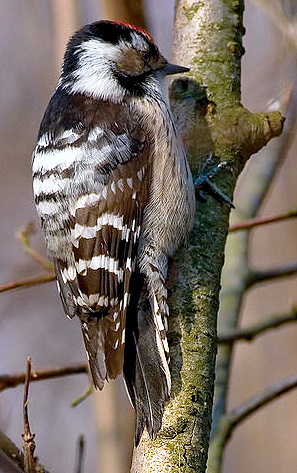Article
Lesser Spotted Woodpecker
Latin Name: Dendrocopos Minor
The Lesser Spotted Woodpecker is the smallest of
the 3 woodpeckers resident in Britain. It tends to nest and feed higher up in
trees and it's 'drumming' is a lot quieter than that of the Great Spotted. When
feeding it creeps along branches and flutters from branch to branch.
Best time to see them is in spring when it is
active and there are not too many leaves on the trees, and it is at this time
when they are likely to be calling and drumming.
Populations of Lesser Spotted Woodpeckers are
mostly resident, but can be nomadic to some degree. Annual fluctuations in
population numbers are common. The winter temperatures may have a direct affect
on winter survival of Lesser Spotted Woodpeckers by heat loss, whereas weather
conditions during spring have an indirect affect on breeding performance by
affecting food production.
Identification
It is a black and white
small bird, very similar to the Great Spotted Woodpecker, and because of it's
size and the fact it spends most of its time in the tops of tall trees in woods
and parks, this little woodpecker is often overlooked or not recognised. In
flight the Lesser Spotted is so small you may not realise it is a woodpecker but
the rounded wings and short pointed tail should provide clues.
The male has a red crown, a brown forehead, a
black stripe down |


Lesser Spotted Woodpecker
 |
the back of its head, and
another from the base of the bill to the neck. The nape and upper back are
black, but the lower back is barred with black and white stripes. On the wings
are broader and more conspicuous bars. The outer tail feathers are also striped.
The under parts are white with black/brown streaks on the flanks. The bill and
legs are slate-grey. The female is very similar however she has a white crown
rather than red. The juveniles of both sexes have more or less crimson on their
heads.
|
Animal
Facts
In Britain: All year
Life Span: Maximum recorded age 6yrs 3
months.
Statistics: Length 14cm, Weight 21g, Wingspan 26cm
Habitat: Forests and woodlands
Food: insects and their larvae as well as
spiders.
Breeding: 4-6 eggs laid around late May,
incubation 14-15 days, young fledge at 19-22 days. Its nest will be high up in
the tree may be 30 or 40 feet up. It makes a hole about 1-2 inches wide and
creates a nesting cavity about 12 inches below the opening. Both birds incubate
and they generally only have one brood.
|
Conservation
Status

Least Concern |
Distribution: In the UK there are thought to be around 1,400-2,900
breeding pairs. It is mainly found in the south with it's highest population
density in the south east of England. They do not breed in Scotland or on
islands such as the Isle of Wight, although they can be found on the Channel
Islands. In northern England they are found in local populations in Yorkshire,
rare in Lancashire and in Wales there are scattered pairs. They are not found in
Northern or Southern Ireland.
Behaviour:
From autumn to spring it hunts mainly on
wood-living insect larvae, frequently from thin dead branches in living trees.
It chips away at the rotten wood, and the litter at the foot of a tree is often
the first indication that insects are attacking upper branches. Through the
breeding season, surface-living insects from the foliage and bark of trees make
up an increased amount of the diet. Young are mainly fed with surface-living
insects, such as aphids and larval insects. At night it roosts in old holes.
Conservation Status: Least concern worldwide, however in the UK the RSPB
have them flagged at their Red Status which signifies a rapid decline in the UK
breeding population over the last 25 years.
See Also
Green
Woodpecker

Great Spotted Woodpecker

Photographing Woodpeckers

BTO Web

RSPB - Lesser Spotted Woodpecker
 - a sound
recording - a sound
recording
Wikipedia
 |